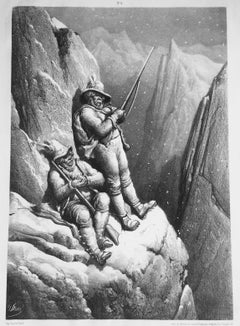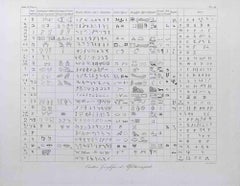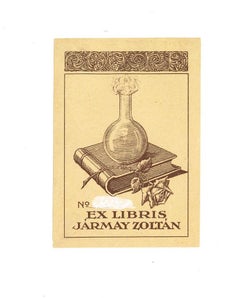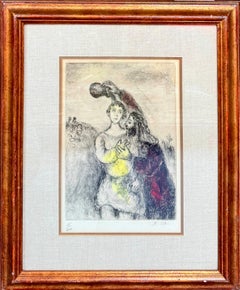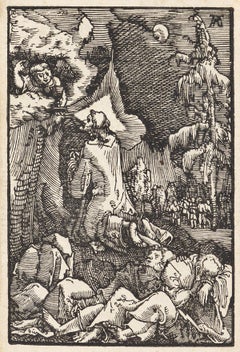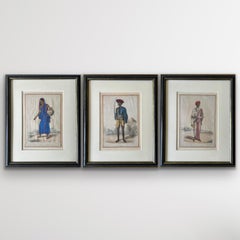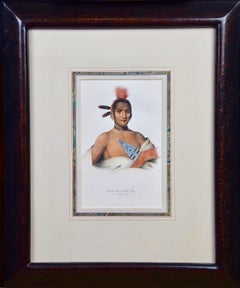1850s More Prints
to
2
3
Overall Width
to
Overall Height
to
2
1
241
490
4,326
3,001
31
55
75
124
230
334
713
1,010
571
378
177
2
1
1
1
1
1
1
Period: 1850s
CHASSEURS TYROLIENS A L'AFFUT DU CHEVREUIL
By Gustave Doré
Located in Santa Monica, CA
GUSTAVE DORE (French 1832-1883)
CHASSEURS TYROLIENS A L'AFFUT DU CHEVREUIL (Tyrolian Hunters at the end of the Hunt) c. 1856-7 (Beraldi?)
Lithograph,...
Category
Romantic 1850s More Prints
Materials
Lithograph
$500 Sale Price
54% Off
Hieroglyphics Alphabets - Etching by Domenico Klemi Bonatti - 1850s
Located in Roma, IT
Hieroglyphics Alphabets is an Etching realized by Domenico Klemi Bonatti in the 1850s.
Signed on the plate.
Good condition with folding and foxing on margins.
Domenico Klemi Bonat...
Category
Modern 1850s More Prints
Materials
Etching
Ex Libris Jarmay Zoltan - Woodcut - Early 20th Century
Located in Roma, IT
Ex Libris Jarmay Zoltan is an original Contemporary Artwork realized in the 19th Century.
Original Ex Libris.
Original B/W woodcut print on ivory-colored paper. Titled on the centr...
Category
Modern 1850s More Prints
Materials
Woodcut
Related Items
The Anointing of Saul
By Marc Chagall
Located in OPOLE, PL
Marc Chagall (1887-1985) - The Anointing of Saul
Etching from 1958.
Edition of 100
Enhanced with watercolour by the artist.
Dimensions of work: 52 x 37 cm.
Hand signed.
Publish...
Category
Modern 1850s More Prints
Materials
Etching
Christ on the Mount of Olives
By Albrecht Altdorfer
Located in New York, NY
A brilliant and early impression of this woodcut. Dark, well-inked, with strong contrasts and no sign of wear. From "The Fall and Salvation of Mankind Through the Life and Passion of Christ."
Category
Renaissance 1850s More Prints
Materials
Woodcut
Rare 1922 German Jewish Judaica Zion Woodcut Woodblock Print Hermann Fechenbach
By Hermann Israel Fechenbach
Located in Surfside, FL
Title: Zion
Subject: Various biblical images depicting Creation and prayer
1922
Medium: woodcut
Frame: 14" x 18"
Image: 12.5" x 16.75"
Provenance: owned and signed verso by Peter Keil.
Central panel shows the Jewish star over a crown, with inscription in Hebrew: "When God comforts Zion, He will comfort all its ruins and make its deserts look like Eden," and "You have sanctified the seventh day, the goal of creation of Heaven and Earth." This is flanked by a Palestinian farmer pioneer on the left and a Jew praying on the right. The lower tier shows six vignettes of the days of creation from Genesis.
Hermann Fechenbach was born in 1897 in Württemberg, Germany. He grew up in Bad Mergentheim where his parents had an inn, which served as a meeting place for the local Jewish community.
He left school early and through family connections with clothing retailers received training in window dressing. His skill with brush writing was quickly recognised by a big firm in Dortmund where he was responsible for the displays in 10 large windows. He received his conscription papers in 1916 and recalls “being as patriotic as any other fool”. In August 1917 he was involved in a grenade attack in which he was the sole survivor. With serious injuries to both legs he struggled to safety and was eventually transported to a front line “slaughterhouse” where the first of a series of amputations was performed which led to the loss of his left leg.
As a result of his injuries his father dropped his opposition to him becoming an artist. His formal art education started in 1918 with training at a Stuttgart handcraft school for invalids. He attended the Academies in Stuttgart and Munich to learn painting and restoration for 3 years. He was influenced at this time by Max Liebermann. He has been compared to Kathe Kollwitz and was a contemporary of Jakob Steinhardt and hermann Struck. In 1923 he went to Florence for a year. While in Florence he started to produce a series of miniature wood engravings to illustrate the stories of Genesis. This was followed by periods in Pisa, Venice, Vienna and Amsterdam. In 1924 he returned to Stuttgart to paint in the contemporary style “Die Neue Sachlichkeit”. (The New Objectivity was a movement in German art that arose during the 1920s Weimar republic as a reaction against expressionism. The term was coined by Gustav Friedrich Hartlaub, the director of the Kunsthalle in Mannheim, who used it as the title of an art exhibition staged in 1925 to showcase artists who were working in a post-expressionist spirit. These artists—who included Max Beckmann, Otto Dix, George Grosz, Christian Schad, Rudolf Schlichter and Jeanne Mammen) Every spring and autumn he exhibited at the “Kunstgebit” which served as the showcase for all serious artists of the period.
His professional status “Kunstmaler und Grafiker” was recognised by Berlin in 1926. Practically all his work from this period was sold following exhibition.
In 1926 he collaborated with an architect friend to build a bungalow in Hohenheim, a non-Jewish area and a suburb of Stuttgart. Hermann alternately lived in his country bungalow and his town studio, producing portraits for sale or barter and wood engravings for his own pleasure.
In 1930 he married a non-Jewish professional photographer – Greta Batze. They had a studio in Stuttgart, which was used to teach art to a group of 12 students.
In 1933 the Nazi influence removed his name from the official state register together with the right to exhibit. By spending most of his time in his bungalow out of the Jewish quarter the Fechenbachs escaped being registered by the Nazis for some years. They were ostracised and abused by their non-Jewish neighbours. Hermann made weekly visits to friends in town to teach them the practical skills they would need assuming they were to escape from Germany. His energies were directed towards protection and survival.
Ultimately the Nazi persecution forced the Fechenbachs to flee their homeland. They moved to Palestine for 3 months in 1938, but found the political and physical environment unsustainable.
Greta arrived in England penniless in January 1939 to work as a domestic servant and to find a guarantor for her husband. Hermann arrived in May 1939. They moved to Blackheath a few months later. Hermann resumed his painting and engraving as a means of earning a living. He raised enough money to get his parents out of Germany to join his brothers in Argentina but was unable to save his twin sister Rosa who died in a Nazi concentration camp. In 1940 Hermann was interned in Bury as a suspect alien. He protested about his treatment by starting a hunger strike. Because of his persistence he was moved to a prison in Liverpool. From Liverpool he was moved to the Hutchinson Camp in the Isle of Man with fellow artist Kurt Schwitters. Arrangements were made for Greta to be accommodated near by. While interned he commenced work on “Refugee Impressions”, a series of linocut prints (no wood was available).
In 1941 when released from internment the Fechenbachs came under the sponsorship of Dr. Bela Horovitz, the Austrian art publisher who in turn made an introduction to Professor Tancred Borenius.
They were offered lodgings with a family in Oxford. Hermann had his first public exhibition for many years in a small gallery in Oxford in 1942. A second exhibition of oils, pencil drawings, coloured linocut and woodblock prints held later in the year was opened by the mayor of Oxford and critically acclaimed.
In 1944 the first London exhibition took place at the Anglo-Palestinian club in Piccadilly. There were two exhibitions at the Ben Uri Art gallery during this period.
In 1948 a second exhibition at the Anglo Palestinian club was inaugurated by a member of the Rothschild family and several members of Parliament. This was a great success.
In 1944 the Fechenbachs moved to a top floor studio flat in Colet Gardens. Open exhibitions were held each Spring at the Embankment from 1946 to 1951. Movietone News produced a short feature on the artist, which was shown in cinemas in England and Germany.
In 1969 he published the Genesis story in a hard back volume containing 137 prints. He started to research the fate of the entire Jewish community of Bad Mergentheim during the period of the second world war, liaising with historian Dr. Paul Sauer and Professor Max Miller, historian and theologian. In 1972 Kohlhammer published his partly autobiographical book “The last Jews of Mergentheim”. He exhibited at the Anglo-Palestinian Club & the Ben Uri Gallery in the 1940s. His works only came to prominence during the last year of his life when he exhibited at Blond Fine Art.
Peter Keil part of the Junge Wilde. In 1978, the Junge Wilde painting style arose in the German-speaking world in opposition to established avant garde, minimal art and conceptual art. It was linked to the similar Transavanguardia movement in Italy, USA (neo-expressionism) and France (Figuration Libre). They were also known as the Neue Wilde. Artists included; Austria: Siegfried Anzinger, Erwin Bohatsch, Herbert Brandl, Gunter Damisch, Hubert Scheibl, Hubert Schmalix...
Category
Impressionist 1850s More Prints
Materials
Woodcut
Qua-Ta-Wa-Pea, A Shawnee: 19th C. Folio Hand-colored McKenney & Hall Lithograph
Located in Alamo, CA
This is an original 19th century hand-colored folio-sized lithographic portrait of a Native American entitled "Qua-Ta-Wa-Pea, A Shawanoe Chief", from McKenney and Hall's 'History of the Indian Tribes of North America'. It was lithographed by J. T. Bowen after a painting by Charles Bird King and published by E. C. Biddle in Philadelphia in 1836. Quatawapea wears a maroon head covering, a white ruffled shirt and blue shawl with gray trim. His presidential peace medal is attached to a maroon fabric...
Category
Naturalistic 1850s More Prints
Materials
Lithograph
McKenney & HallQua-Ta-Wa-Pea, A Shawnee: 19th C. Folio Hand-colored McKenney & Hall Lithograph, 1836
$1,820 Sale Price
20% Off
H 20 in W 14.5 in
Fishing Off Hastings, England: A Framed 19th C. Engraving After J. M. W. Turner
By J.M.W. Turner
Located in Alamo, CA
This beautiful 19th century framed engraving "Line Fishing Off Hastings" by William Miller is based on an original painting by the renowned British artist J.M.W. Turner, which depicts a scene of fishermen at work off the coast of the town of Hastings in East Sussex, England. The Miller engraving faithfully reproduces Turner's painting, capturing the same atmospheric quality and sense of motion. In the foreground of the image, a group of fishermen are shown in a small boat, with one man using a fishing line to catch fish. In the background, there is a larger ship, along with a view of the town of Hastings and the cliffs beyond. Overall, the Miller engraving "Line Fishing Off Hastings" is a beautiful and detailed representation of Turner's original painting, and provides a glimpse into life in a 19th century fishing community.
This colorful 19th century engraving is presented in a gold-colored wood frame and a cream-colored French mat highlighted with a light blue band and thinner mustard and gold-colored bands. There is a gold-colored fillet which further embellishes the engraving. The frame measures 18" high, 20.5" wide and 1" deep. The engraving, frame and mat are in excellent condition.
Joseph Mallord William (J.M.W.) Turner (1775-1851) was an English painter who is widely considered one of the greatest landscape painters in Western art history. Born in London, he showed a remarkable talent for art from a young age, and studied at the Royal Academy of Arts from the age of 14. He quickly gained recognition for his watercolor landscapes, which were highly innovative and expressive. Turner's style evolved over time, and he became increasingly interested in the effects of light and color. He traveled extensively throughout Europe, and his experiences of the natural world, particularly the sea and the sky, had a profound influence on his art. His paintings are known for their luminosity, atmospheric effects, and dramatic use of color. Despite facing criticism and ridicule from some of his contemporaries, Turner continued to push the boundaries of art, experimenting with new techniques and styles throughout his career. He was a prolific artist, creating thousands of paintings, sketches, and watercolors, and his legacy continues to inspire artists today.
William Miller (1796-1882) was an English engraver and publisher, best known for his work in reproducing the paintings of J.M.W. Turner. Miller was born in Bristol and began his career as an engraver at a young age, working for a variety of publications and artists. In the early 1820s, Miller began working with Turner, engraving many of the artist's most famous works, including "The Fighting Temeraire...
Category
Romantic 1850s More Prints
Materials
Engraving
$460 Sale Price
20% Off
H 18 in W 20.5 in D 1 in
The Fighting Temeraire: A Framed 19th C. Engraving After J. M. W. Turner
By J.M.W. Turner
Located in Alamo, CA
This beautiful 19th century framed engraving "The Fighting Temeraire" by James Tibbetts Willmore is based on an original painting by the renowned British artist J.M.W. Turner. It was published by James S. Virtue & Co. in London between 1859-1875. It depicts the once mighty British warship the HMS Temeraire being towed away down the river Thames by a much smaller steamboat to a ship-breaking yard to be broken up for scrap. The Temeraire was first launched in 1798 and represented the pinnacle of British ship-building. 180-feet long, constructed of English oak and armed with 98 guns, she was one of the largest warships of the period. The Temeraire became a symbol of British pride and military power that endured throughout the 19th century. The man-of-war served during the French Revolutionary and Napoleonic Wars and was among the last serving ships to have been at the Battle of Trafalgar in 1805. It became one of the many older ships put out of service in the 1830s and 1840s. The once mighty and feared ship symbolizes a once magnificent, but now obsolete, technology. Turner seems to lament her inglorious final journey, being towed by a less magnificent, but modern steam powered tugboat.
The Turner painting was created in 1838 and is now held in the National Gallery in London. Willmore's engraving, created in 1859, captures the dramatic scene with great detail and skill. The image has become an iconic representation of the decline of Britain's naval power and the transition from sail to steam in the 19th century. The sunset in the background is symbolic of the sun going down on British naval power and tradition. The painting conveys profound and diverse themes that are central to the human experience: those of mortality and change, technology and progress, heroism and brutality. The painting demonstrates Turner’s skill as an artist. His ability to produce scenes of great beauty that are dramatic, but are also symbolic, stimulating both thoughtful analysis, as well as emotion. Turner's painting was voted by the British public in a 2005 BBC radio sponsored survey to be the British people's favorite painting of all time. In 2020 it was included on a new British banknote...
Category
Romantic 1850s More Prints
Materials
Engraving
$540 Sale Price
20% Off
H 18 in W 20.5 in D 1 in
A View of Dover, England: A Framed 19th C. Engraving After J. M. W. Turner
By J.M.W. Turner
Located in Alamo, CA
This beautiful 19th century framed engraving "Dover" by Thomas Lupton is based on an original painting by the renowned British artist J.M.W. Turner, which depicts a panoramic view of the harbor of Dover, a town in southeastern England, that has been an important port for centuries. The engraving captures the dramatic sky and sea that Turner was known for, with billowing clouds and waves crashing against the shore. The town and its famous white cliffs are visible in the background, while ships and boats dot the harbor in the foreground. Several wooden rowboats...
Category
Romantic 1850s More Prints
Materials
Engraving
$460 Sale Price
20% Off
H 18 in W 20.5 in D 1 in
Mick Jagger X - Andy Warhol, Announcement card, Rolling Stones, Musician, Pop
Located in Knowle Lane, Cranleigh
Mick Jagger X - After Andy Warhol. This black and white colour scheme lithographic print features - Mick Jagger - an iconic rock legend who was the frontman and one of the founders ...
Category
Pop Art 1850s More Prints
Materials
Lithograph
$1,269
H 12.01 in W 8.67 in D 0.79 in
A View of Scarborough, England: A Framed 19th C. Engraving After J. M. W. Turner
By J.M.W. Turner
Located in Alamo, CA
This beautiful 19th century framed engraving "Scarborough" by W. Chapman is based on an original painting by the renowned British artist J.M.W. Turner. It was published in London by ...
Category
Romantic 1850s More Prints
Materials
Engraving
$460 Sale Price
20% Off
H 18.25 in W 20.88 in D 1 in
Engraving #1 by Ernst Fuchs: KABBALAH (SEFER YETSIRA and 32 PATHS OF WISDOM)
By Ernst Fuchs
Located in Cliffside Park, NJ
Original engraving #7 by Ernst FUCHS from Kabbalah (THIRTY-TWO PATHS OF WISDOM by SEFER YETZIRA), 1978
Etching signed and numbered 16/30 E.A.
Page size - 30 ...
Category
Modern 1850s More Prints
Materials
Paper, Etching
Tete de Veau (Calf's Head)
Located in OPOLE, PL
Salvador Dali (1904-1989) - Tete de Veau (Calf's Head)
Drypoint etching and watercolor from 1968.
The edition 25/145.
Dimensions of work: 38.5 x 28.5 cm.
Hand signed.
The work i...
Category
Modern 1850s More Prints
Materials
Drypoint, Etching
Kee-Shes-Wa, A Fox Chief: An Original Hand-colored McKenney & Hall Lithograph
Located in Alamo, CA
This is an original 19th century hand-colored McKenney and Hall lithograph of a Native American entitled "Kee-Shes-Wa, A Fox Chief", litho...
Category
Naturalistic 1850s More Prints
Materials
Lithograph
$460 Sale Price
20% Off
H 10.25 in W 7 in
Previously Available Items
India early 19th century hand coloured Lithographs Rare Fanny Parks
Located in Norfolk, GB
Three hand-coloured lithographs from:
Fanny Parks (1794-1875)
Wanderings of a Pilgrim, in search of The Picturesque, During four and twenty years in the East with, Revelations of L...
Category
Other Art Style 1850s More Prints
Materials
Pigment, Lithograph, Paper
H 16.93 in W 13.78 in D 0.4 in
Original Hand-colored McKenney & Hall Lithograph "Mo Na Hon Ga, An Ioway Chief"
Located in Alamo, CA
An original 19th century hand-colored lithograph of a Native American chief entitled "Mo Na Hon Ga, An Ioway Chief". The lithograph by J. T. Bowen is after a painting by the prominen...
Category
Naturalistic 1850s More Prints
Materials
Engraving
McKenney & HallOriginal Hand-colored McKenney & Hall Lithograph "Mo Na Hon Ga, An Ioway Chief", 1855
H 21.75 in W 17.5 in D 1.38 in
Original Hand-colored McKenney & Hall Lithograph "Ki On Twog Ky, A Seneca Chief"
Located in Alamo, CA
An original 19th century hand-colored lithograph of a Native American chief entitled "Ki On Twog Ky, A Seneca Chief", also known as Corn Plant. The lithograph by J. T. Bowen is after...
Category
Naturalistic 1850s More Prints
Materials
Engraving
H 21.5 in W 17.5 in D 1.38 in
Plan of Louisville, KY. and the Vicinity.
Located in New York, NY
A very rare map and view of the city of Louisville, KY., and Vicinity is an undated stone engraving created circa 1850. It was drawn by J. L. Heming, civil engineer, and printed by ...
Category
American Realist 1850s More Prints
Materials
Engraving
THE EAGLE FINDERS (LES DENICHEURS D'AIGLES)
By Gustave Doré
Located in Santa Monica, CA
GUSTAVE DORE (French 1832-1883)
LES DENICHCURS D'AIGLES, (THE EAGLE FINDERS) c. 1856-7 (Beraldi 73?)
Lithograph signed in the stone at lower left image corner. U...
Category
Romantic 1850s More Prints
Materials
Lithograph
Clipper Ship Flying Cloud
Located in Missouri, MO
Large-folio handcolored lithograph after James E. Buttersworth, E. Brown, Jr., delineator, published by N. Currier, New York, 1852. Sheet size 21 ¾ x 27 ½ inches, sight. Frame 30 x 3...
Category
Realist 1850s More Prints
Materials
Lithograph
Map of England & Wales, 1850
Located in Houston, TX
Over 150 year old engraved map of England and Wales from 1850. Original hand color. Insert shows detail of Northumberland, Roxburgh and Berwick.
Or...
Category
1850s More Prints
Materials
Ink, Watercolor, Handmade Paper
Very large - GLOBE LOCOMOTIVE WORKS
By John Swyney
Located in Santa Monica, CA
GLOBE LOCOMOTIVE WORKS - Passenger Engine, Boston, Mass 1854
Lithograph with hand coloring. John Swyney del, J. H. Bufford’s Lith. 260 Washington St. Boston. 20 ¾ x 30 ¾”, sheet 2...
Category
American Realist 1850s More Prints
Materials
Lithograph
North America
By J. Archer
Located in Saint Augustine, FL
An original hand-colored steel plate map engraving on wove paper by English artist J. Archer (Active: Mid 19th Century) titled "North America", c. 1850....
Category
Victorian 1850s More Prints
Materials
Steel
Recently Viewed
View AllMore Ways To Browse
Gustav Klutsis
Ihap Hulusi
Ivan Navarro
James B Painter
James Bond Movie Posters
Jan V Roy Posters
John Lennon On Sale
Lait Pur Sterilize
Lake District Vintage Travel Poster
Land Rover Poster
Le Frou Frou Vintage Poster
Leon De Pas
Leon Wuidar
Lillian Snelling
Man Ray Electro Magie
Maurin Quina Print
Michael Schwab Posters
Miroslav Sutej
